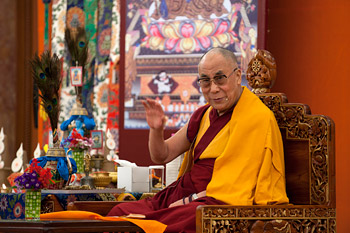
His Holiness the Dalai Lama speaking during the final day of his three day teaching in New Delhi, India, on March 24, 2013. Photo/Tenzin Phuntsog/NAVA
A Medicine Buddha Blessing to Complete the Series of Teachings in Delhi
New Delhi, India, 24 March 2013 – Many of those who have been attending His Holiness the Dalai Lama’s teachings, organized by the Foundation for Universal Responsibility at the Taj Mahal Hotel in Delhi over the last two days, were waiting when he arrived early this morning to undertake the preparatory rites for the Medicine Buddha blessing he was going to give. They shared a quiet half an hour together while His Holiness performed the requisite meditations. Then he resumed his explanation of Atisha’s “Lamp of the Path” and Je Tsongkhapa’s “Abbreviated Stages of the Path.” He noted the correspondence between the verse in the “Lamp,”
Just as the bird with undevelopedWings cannot fly in the sky,
Those without the power of higher perception
Cannot work for the good of living beings.
and a verse in Nagarjuna’s “60 Stanzas on Reasoning,”
On the two wings of understanding
Conventional and ultimate reality,
May the King of Swans fly
Across the ocean of cyclic existence.
Referring to Buddha nature, His Holiness said that the ultimate source of the mind of a Buddha is the innermost subtle mind. We, each of us, have such a potential in the form of the subtlest mind within our minds. However, we should not make the mistake of thinking that having Buddha nature means that we are somehow Buddhas already. We do not think of the seed of a tree as somehow containing an already fully grown tree, despite the potential for such a tree being within the seed.
His Holiness mentioned that all Buddhist teachings are based on the Four Noble Truths that were taught during the first turning of the wheel of Dharma. The second turning of the wheel of Dharma, which includes the Perfection of Wisdom sutras, particularly clarifies the meaning of cessation and the possibility of achieving it. It also dealt with the qualities of a Buddha. The third turning of the wheel includes teachings for those who found what was said in the second turning, that things have no essence, hard to accept. The Buddha explained things from another angle referring to the things’ dependent nature, perfect nature and imputed nature. The third turning of the wheel also explains the most subtle mind, which is the basis for tantra.
In connection with developing a calmly abiding mind His Holiness explained the seven features of the posture of Vairochana, which include fully crossed legs, a straight back, hands joined in the meditation mudra at the navel, the head slightly bent forward, the lips and tongue resting in a natural position. To these can be added an eighth feature – observing the breath. His Holiness led everyone through the stages of the nine round breathing practice that derives from the Six Yogas of Naropa and which he recommends for calming an agitated mind.
Next, he explained the object of visualisation, that for Buddhists can be an image of the Buddha: “Visualise an image of the Buddha about one inch high at the level of your brows and about four feet in front of you. See it as bright and radiant, which sharpens your mind, and yet think of it as being heavy, which has the effect of stabilising the mind.”
He suggested that Christians could focus on images of Jesus or Mary, as they wished, and that Muslims might employ an image of Mecca. Whatever object you choose there are two obstacles to developing concentration: distraction, for which the antidote is mindfulness, and sinking, as a result of which the object is not clear and sharp, which is countered by alertness. If you want to achieve clarity of mind it’s important to be happy and alert.
Reaching the vipasyana or special insight section of the texts, His Holiness noted the great qualities of Nagarjuna’s “Fundamental Wisdom” and the various commentaries to it by Buddhapalita, Bhavaviveka and Chandrakirti. He recalled an occasion 40 years ago when the great Sanskrit scholar Upadhyaya came to see him: “I asked him to recite the opening verses of Chandrakirti’s “Prasanapada” in Sanskrit, which he did and it brought tears to my eyes to listen to him.”
Finally, because employing the subtle mind is more effective for reaching enlightenment, Atisha refers to embarking on the tantric path. Similarly, Je Tsongkhapa says that having practised the six perfections, combined concentration and wisdom and traversed the common path, you should enter the path of tantra. His Holiness remarked that while in terms of sutra what the various Tibetan Buddhist traditions study is the same, the ways they practise tantra are different. He explained that in the Nyingma tradition there are practices related to the long lineage that came from India, the short lineage revealed in treasures and the close lineage derived from pure visions. The Medicine Buddha blessing he was about to give comes from such a vision of the Fifth Dalai Lama, who like the Second Dalai Lama before him experienced a multitude of visions.
At the end of the Medicine Buddha blessing, His Holiness expressed his happiness over the way the teachings had gone and looked forward to a similar meeting next year. He thanked the organizers and staff, and the Taj Mahal Hotel for providing facilities and hospitality. His final request to those who had attended the teachings was that they share what they had heard with others: “Share the idea of warm-heartedness with your family and friends; that’s the way we can spread awareness.”
His Holiness then left directly for the airport to fly to Bagdogra in West Bengal, where he was received by Tsechokling Rinpoche, Secretary of the Sikkimese Ecclesiastical Affairs Department. From there he flew by helicopter to Ravangla where he has been invited to consecrate a colossal statue of the Buddha and teach. http://www.dalailama.com/news/post/919-a-medicine-buddha-blessing-to-complete-the-series-of-teachings-in-delhi